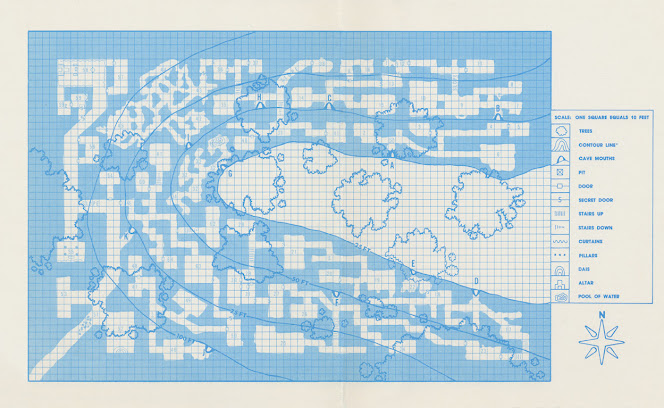Zahallas, City of the Mages.
On a quiet peninsula in the west, on the southern reaches of The Thousand Miles, lays the city of Zahallas, a gray maze of impossible walkways and non-euclidean rooms. It's impossible to recreate. It's architecture disobeys all logic and reason. This betrays the fact that Zahallas doesn't exist.
Zahallas is as much a college as a city. All are permitted within its walls to learn, though the laws of the city are strict. None are permitted to speak within Zahallas' walls. It is said this is to make the casting of any spells obvious. While true, it is not the reason. There is a fear that speaking will remind the city that it does not exist.
Zahallas was not built. It appeared one day, thick with dust as if untouched by time for countless ages. The land surrounding it is gray and lifeless, though foolish creatures do make their home in and around the silent city. There is no sky within a hundred miles of Zahallas. The magic of clerics does not work there. The gods cannot hear you. This is because Zahallas doesn't exist.
The Winedark Hand.
When the city was first discovered, 7 mages found an ancient artifact at its heart: a seven fingered hand colored deep purple. Each mage took a finger, and together formed a council known as the Winedark Hand. The Hand ostensibly rule Zahallas, though most bow to the rules of various colleges and schools rather than the Hand directly.
When combined, the seven fingered hand can distort reality, change the truth of the world. This makes it dangerous. Now separate, the hand is greatly weakened. Each finger is powerful, yes, but nowhere near the truth distorting nature of the full hand. Many have tried to recombine the hand. All have failed.
Each member of the Winedark Hand is known as a finger, first through seventh, and holds the respective finger of the seven fingered hand. Each finger enhances certain forms of magical ability, allowing each mage to perform magical feats of immense power. Each finger also makes the mages decadent and lazy. With the fingers, the Winedark Hand could conquer Neurim. It is lucky that the fingers make this a nigh impossibility.
Navigating Zahallas.
Zahallas is a city of impossible geometry. Navigating it is a learned skill. When halls occupy the same space and buildings are larger on the inside with exits on the opposite side of the city as their entrances, navigation by normal means is impossible.
Attempting to get somewhere in the city without help is basically impossible (5% chance). A navigator can be hired for 10 gold per day. In addition, anyone native to the city or with at least 1 level in an arcane spell casting class can navigate the city with ease. The city is easy to navigate when you ignore physical space and only look at it through magical means.
The Skyless Wilds.
The peninsula Zahallas sits on is a lifeless gray waste. Grass grows, but it is devoid of color and ceases to exist when you look at it closely. Trees appear, but only at the edges of your vision. Sometimes you might feel the touch of the wind of the heat of the sun, but these feelings will fade. After all, Zahallas doesn't exist.
These wilds are scarred by magical experiments. Burnt out craters, illusions like theater screens, and conjured beings that have forgotten how to leave. The wilds are uniquely dangerous unless one sticks to the protected road to Zahallas. Any other route leads to danger and starvation.
Creatures of the Skyless Wilds.
Formless Conjurations.
Many conjurations fail to stop existing within the Skyless Wilds (20% chance). Those that fail to return to magical energy and live on eventually forget what they were, becoming a gray mass of false flesh similar to an ooze. They have no intelligence and are drawn to large sources of magical energy.
Roll a d6. That's how hit dice they have. Conjuring spells can be used to constrain them back in a form and remove their hostility.
Mana Kites.
Like a giant manta ray with leathery brown skin and obvious veins. Wings with a diameter of up to 3 feet, and long spindly bodies. They float 5-10 feet in the air, skimming magical residue. 1 hit die, but can only attack by casting magic missile as a 1st-level caster. They'd rather flee than fight thought.
Lost Dead.
When one dies in the Skyless Lands, they must be returned to the rest of the world within a week or their soul will be stuck in the Skyless Lands forever. These lost souls are incapable of finding an afterlife, which brings them great dissatisfaction. Their only goal is to find peace.
Like a ghost, except all they do is posses people, walk them out of the Skyless Lands, and then use their bodies to commit suicide. Doing this leaves the soul of the body behind, who become one of the lost dead. Any of the seven fingers can be used to destroy lost dead permanently.
Superpositers.
A sagging and round body held up by four spindly legs, like those of a harvestman. Their bodies are bright blue, and they're about the same size as a full grown human. They have massive fangs, nearly a foot long, but the fangs are stored in the body when not in use.
They exist in multiple places at once. They can occupy anywhere within a 10-foot sphere, appearing blurry and shifting constantly. This makes them impossible to hit through sources such as swords or arrows, but fireballs and magic missiles work perfectly. After being hit, their position is known until their next turn, when they go back to being anywhere. They have 3 hit dice, and their fangs do damage like a great axe.
Truly ancient superpositers can reach the size of buildings. At this size, their legs are like spears and their fangs like boulders. You would struggle to fight one. They live underground, sleeping for ages. Their skin and fangs can be used to create superposition armor and weapons respectively. They lie about where you or your weapon really are. Be wary of them. A superposition fighter would be unbeatable.






